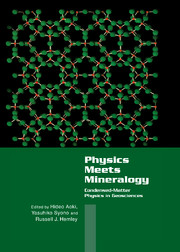Book contents
- Frontmatter
- Contents
- Preface
- List of Contributors
- Part I Introduction
- Part II Advances in Theoretical and Experimental Techniques
- Part III New Findings in Oxides and Silicates
- Part IV Transformations in Silica
- Part V Novel Structures and Materials
- Chapter 5.1 Opportunities in the Diversity of Crystal Structures – A View from Condensed-Matter Physics
- Chapter 5.2 Theoretical Search for New Materials – Low-Temperature Compression of Graphitic Layered Materials
- Chapter 5.3 H…H Interactions and Order–Disorder at High Pressure in Layered Hydroxides and Dense Hydrous Phases
- Part VI Melts and Crystal–Melt Interactions
- Subject Index
- Materials Formula Index
- Index of Contributors
Chapter 5.2 - Theoretical Search for New Materials – Low-Temperature Compression of Graphitic Layered Materials
Published online by Cambridge University Press: 05 November 2011
- Frontmatter
- Contents
- Preface
- List of Contributors
- Part I Introduction
- Part II Advances in Theoretical and Experimental Techniques
- Part III New Findings in Oxides and Silicates
- Part IV Transformations in Silica
- Part V Novel Structures and Materials
- Chapter 5.1 Opportunities in the Diversity of Crystal Structures – A View from Condensed-Matter Physics
- Chapter 5.2 Theoretical Search for New Materials – Low-Temperature Compression of Graphitic Layered Materials
- Chapter 5.3 H…H Interactions and Order–Disorder at High Pressure in Layered Hydroxides and Dense Hydrous Phases
- Part VI Melts and Crystal–Melt Interactions
- Subject Index
- Materials Formula Index
- Index of Contributors
Summary
The synthesis of new materials by compressing graphitic layered materials at low temperatures is proposed on the basis of first-principles molecular-dynamics simulations. It is predicted that a class of BCN heterodiamonds are derived from graphite/h-BN superlattices. It is also suggested that compression of a graphite intercalation compound results in an exotic diamond-like material. Differences in layer stacking, intercalants, and stage structures of intercalants in the starting layered materials will result in fruitful variations of the resultant materials.
Introduction
Predicting the structures and properties of materials from a knowledge of their chemical composition has been a long-standing problem of materials science [1]. Thanks to the recent development of computational science approaches, it is often not as difficult to predict stable structure and elctronic properties of even unknown materials theoretically, if we know or assume a rough arrangement of the constituent atoms in the material. It is much more difficult, however, to know how to make it and how stable it is compared with other unknown structures beyond our imagination, as we need overall knowledge of the potential-energy surface in the multidimensional configuration space to do so. An exceptionally simple and hopeful situation for such theoretical designs of materials can be found in the low-temperature compression of crystals.
Some crystals compressed at low (room) temperature undergo structural transformation without atomic diffusion (martensitic transformation), resulting in metastable structures inaccessible at thermal equilibrium or by rapid quenching of high-temperature/pressure phases.
- Type
- Chapter
- Information
- Physics Meets MineralogyCondensed Matter Physics in the Geosciences, pp. 299 - 307Publisher: Cambridge University PressPrint publication year: 2000
- 1
- Cited by



